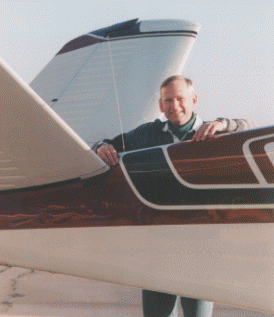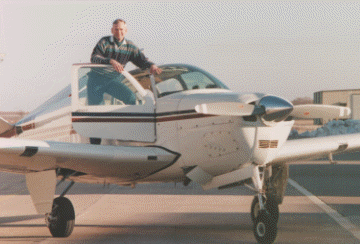 Aviation is my passion.
Aviation is my passion.Dave Chael-Newsletter Editor
 Aviation is my passion.
Aviation is my passion.
I also like Robert Frostís famous poem, The Road Not Taken:
TWO roads diverged in a yellow wood,
And sorry I could not travel both
And be one traveler, long I stood
And looked down one as far as I could
To where it bent in the undergrowth;
Then took the other, as just as fair,
And having perhaps the better claim,
Because it was grassy and wanted wear;
Though as for that the passing there
Had worn them really about the same,
And both that morning equally lay
In leaves no step had trodden black.
Oh, I kept the first for another day!
Yet knowing how way leads on to way,
I doubted if I should ever come back.
I shall be telling this with a sigh
Somewhere ages and ages hence:
Two roads diverged in a wood, and I--
I took the one less traveled by,
And that has made all the difference.
So I took the road not taken, and it really did make all the difference! In 1983 I was selected to attend the Air Force Officer Training School in San Antonio, Texas, with a follow-on pilot training school slot. I was commissioned as a 2d Lt, and promptly found myself looking at a map to find out where in the world Enid and Vance Air Force Base were! "It was the best of years, and the worst of years" all rolled up into one - without a doubt, Air Force Pilot Training was the most challenging thing Iíve ever done, and also without a doubt the most rewarding! After graduation, I was selected to come right back to Vance to fly the T-38 (advanced supersonic trainer) as an instructor and it was a ball! I flew here as an IP from 1985 thru 1989, "wearing nothing but my speed jeans (G-suit) and had my hair on fire" most of the time. Yehaaa!
My first exposure to the EAA and sport aviation came in the mid 1980s, when I met Kevin Ross at Vance. We both were flying the T-38, and all he seemed to talk about was sport aviation and building airplanes (now I understand why!). His invitation to join the Enid EAA chapter was another real turning point in my life. I became associated with a group of the most wonderful, generous and dedicated people Iíve even known anywhere. Also while in Enid, I met my lovely bride Sue and she managed to convince me to slow down a bit and do something really radical Ė get married! After living vicariously through "everyone else" who owned airplanes, we decided to give it a shot. Our first airplane was a 1974 Cessna 150M. When we got the airplane, it flew OK, but looked just awful! Hey, it was slow, but at least it was ugly. Those of you who were here in 1985 remember our year-long restoration effort, that hooked me for life on the hobby of working with airplanes! (See attached before-and-after photos, N103DC).
The Air Force needed cargo pilots, so we pulled-up roots and headed northwest to McChord AFB in Tacoma, Washington to fly the C-141. The bank in Tacoma convinced me (reluctantly) to sell our Cessna 150 so we could afford to buy a house. Donít listen to the bank. Mica Doane taught me a very valuable lesson back then, when he said: "Remember, you can sleep in your airplane, but you canít fly your house!" But everything worked out well in the end. We got our house, and in time, we finally got another airplane. At Vance AFB I was used to flying a little white jet "around the flagpole", never straying far from home or adult supervision, but at McChord AFB we were instantly thrust into a global go-anywhere, go-anytime mission literally overnight. Before I knew it, I found myself flying in countries I could barely pronounce, and smack in the middle of military skirmishes like Panama (Just Cause), and the war in the sandbox (Desert Storm). I did a lot of growing-up then, and gained a very unique perspective on life in third-world countries around the world. Bottom line: be glad you live in America - Enidís a pretty good place to be!
Following my stint in the heavies, we separated from the Air Force "destined to get that big airline job". NOT! The airlines were NOT hiring in 1991, and while unemployed for over a year, I gained yet another valuable perspective on life. I gravitated back to the local EAA chapter, and was elected (very quickly might I add) to serve as the Chapter 455 President in 1993. I wanted to stay competitive and active in general aviation, and earned my CFI (certified "fright" instructor) certificate. Finally, I was hired on as a T-37 simulator instructor (at Vance, where else?) in 1993, and have been there for what seems like forever now.
 Last
year we got the itch to get another airplane. My boss (Sue) laid down only two
"simple" requirements: #1: Has to have four seats. #2: Has
to be fast. As you all know, that significantly limits the field of
available (or certainly affordable) airplanes. We looked at a lot of airplanes
and finally settled on the Beech V-Tail Bonanza. Initially I wanted a í56 G
model (as I too am a í56 model), but wisely decided to go with a í59 K that
has an IO-470C engine and other upgrades. We found it in May, 2000 at Peachtree
City (Atlanta), and began the lengthy, long-distance pre-purchasing inspection
and loan process (remember that airplanes always look better in pictures
than they do up close and in-person). N35JW was a good candidate for a
mini-restoration, and was somewhat affordable (i.e. needs a heck of a lot of
work). Remembering how much fun I had with the 150, I was ready to get started.
The trip home from Atlanta was pretty exciting! Now, imagine, here I am in an
airplane, a complex airplane, now my airplane, in which Iíd had only an
hour of dual instruction, earlier that day. New avionics, systems, speeds,
procedures, etc. I flew home to Enid the same day, even remembering to put the
gear down every time. Exhausted, but delighted to be home!
Last
year we got the itch to get another airplane. My boss (Sue) laid down only two
"simple" requirements: #1: Has to have four seats. #2: Has
to be fast. As you all know, that significantly limits the field of
available (or certainly affordable) airplanes. We looked at a lot of airplanes
and finally settled on the Beech V-Tail Bonanza. Initially I wanted a í56 G
model (as I too am a í56 model), but wisely decided to go with a í59 K that
has an IO-470C engine and other upgrades. We found it in May, 2000 at Peachtree
City (Atlanta), and began the lengthy, long-distance pre-purchasing inspection
and loan process (remember that airplanes always look better in pictures
than they do up close and in-person). N35JW was a good candidate for a
mini-restoration, and was somewhat affordable (i.e. needs a heck of a lot of
work). Remembering how much fun I had with the 150, I was ready to get started.
The trip home from Atlanta was pretty exciting! Now, imagine, here I am in an
airplane, a complex airplane, now my airplane, in which Iíd had only an
hour of dual instruction, earlier that day. New avionics, systems, speeds,
procedures, etc. I flew home to Enid the same day, even remembering to put the
gear down every time. Exhausted, but delighted to be home!
Last summer (July Ė October, 2000), I spent well over 400 hours conducting the annual/restoration (phase 1), with extensive help and a lot of coaching from Ron Decker. Ron is really outstanding, and KNOWS airplanes! We found a few $urprises, basically from a lack of good, regular maintenance (or TLC) in the past. Because this is a long-term investment, we decided to fix the biggies right the first time, and get to as many of the small things that we could. The most memorable item we fixed (replaced) was the rubber fuel cell (right wing, AUX tank). Now I had heard that fixing these things is a real *$_#^%@#, and now I too can confirm that this is true! Who would have thought that a little "10 gallon rubber bag" could cause so much *$_#^%@# aggravation, and cost so much. I also had no idea that my hands could bend in so many directions (at once), or that my patience level could extend that long. But they did, and it did, and Iím better for it, or so they say! The wonderful thing about doing your own work and helping out with your annual (under the semi-direct supervision of an A&P of course) is that you can learn SO much about so many things and really get to know your airplane and its systems. The restoration effort continues in 2001 with smaller, more manageable (three-day or less) projects. I owe a lot of favors to a lot of folks here in Enid and at Woodring! Airplane ownership WOULD NOT be possible for many of us were it not for the extreme generosity of the Woodring airport community and this EAA chapter! Older airplanes need TLC, and a lot of it! Please donít ask what it costs to fly each hour, because even I donít want to know. Naturally this first year is going to be brutally ugly, if one were to amortize every expense (lots or them) over the flying hours (not many of them). The V-Tail Bonanza is a very complicated, yet very capable airplane that requires a lot of attention to detail, both in the maintenance, and day-to-day flight operation. Thatís why Mica calls it the "twin tailed, gas-guzzliní doctor killer". And for good reason! It can get away from you, especially in the weather, or in the descent for landing, or during the trip to the bank!
Our most memorable Bonanza flight came on the return leg of a trip Sue and I took to San Antonio last November. The weather down on a Friday morning was gorgeous! We stopped in Mineral Wells, TX (near Dallas) for a quick refuel/rest, and arrived in San Antonio just after lunch. This airplane is a real time machine. Life is short, fly fast! Saturday, the weather was OK, but on Sunday we awakened to 100 OVC, visibility Ĺ SM in fog. Bummer. The Dallas forecast called for even lower ceilings, and the forecaster threw in some moderate mixed ice to complicate the takeoff and routing decision. So we waited around for the strong cold front to come barreling through. Dallas looked worse by noon, so we elected to file an instrument flight plan behind the front northwest of San Antonio, and then fly along the back side of the front to Abilene, and then into Enid from there. Bottom line: itís very important to understand weather and how it affects your flight conditions, route of flight, and ultimately your decision to go or not. Be ready to sit, change plans, or even NOT GO (thereís always tomorrow!). Seems time spent studying aviation weather paid off big time that day!
I have a lot of future goals in the works. Iíd like to get a CFII (presently working to add the "second I"), and move up to bigger, more complex airplanes (twins, business-class flying, etc). Corporate flying is not out of the question, but it would have to be the right combination of airplane/company/lifestyle. Iíd love to continue basic instruction for private and instrument candidates here in Enid and for now, Iím haviní a real ball flying the in the Tweet simulator and in the Air Force Reserves. Life should be so good!
Fly safe!